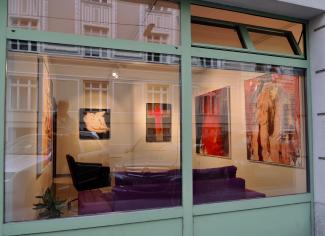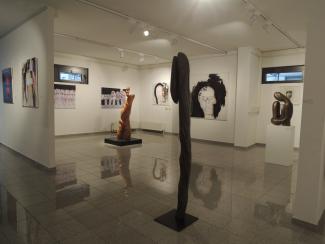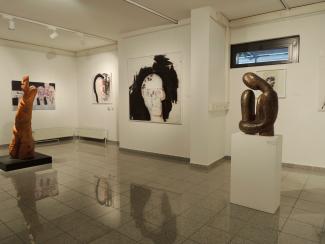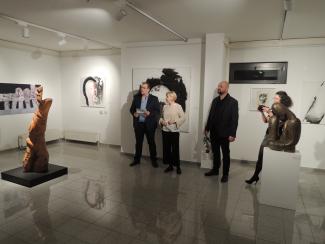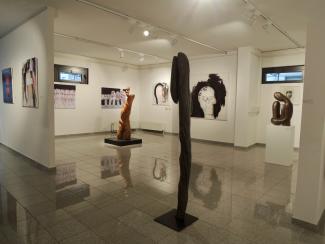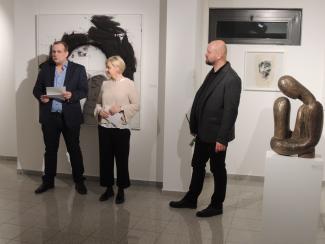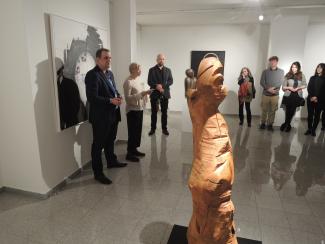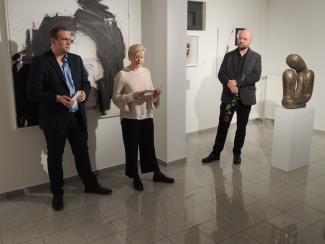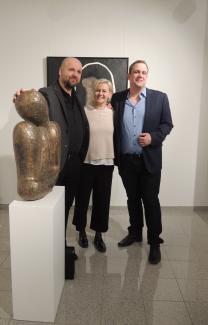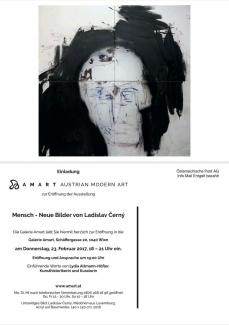Artistic introduction
AMART Gallery | Vienna, 23 February 2017
Do you know him? The cheerful smiler - the haggard old man - the morose one - the constipated one - the nosey mocker - the ill-tempered one - the simple-minded one of the highest order and the arch-villain?
No, I don't mean their neighbour, their boss or even Donald Trump. I mean the so-called character heads by the sculptor Franz Xaver Messerschmidt. He created 69 of them between 1770 and 1780, some of which are in the possession of the Vienna Belvedere. The sight of them exhilarates us. But the question quickly arises: "Who am I - and if so, how many?" For faces, it is said, act as mirrors of the soul - they are expressions of personality - a detailed map of our identity and individuality. Even newborns can distinguish their mother's face from others after only two weeks. And experiments have shown that when we first make eye contact, we almost invariably look into the eyes of the other person. the eyes of the person opposite us. Only a few seconds decide on sympathy or non-sympathy: faces apparently speak volumes. Aristotle already took this as an opportunity to write a treatise on human physiognomy. And in 1770, the Zurich theologian Johann Caspar Lavater even published a four-handed work on the knowledge of human nature, based on the idea that one could deduce a person's moral and intellectual abilities from their facial features. A hundred years later, the Italian Cesare Lombroso went one step further and developed a method for identifying criminals by their outward appearance. According to this method, criminals had protruding incisors, a receding or flat chin, little beard growth and bushy, fused eyebrows.
But what does this tell us about human representation in the visual arts? No matter how realistic a likeness may look at first glance, it is never uninfluenced by personal feelings. A portrait is thus also always an individual interpretation of its creator.
Into these reflections we encounter Ladislav Cerny's images of human beings. They confront us directly and powerfully, so that we cannot escape them. The faces fix us: the male emotion is yellow and one-eyed. Their gaze follows us suspiciously - the right half of their face is black and blind. The other emotion stands under the protection of a red bar. The green of its eyes stares at us. Is it envy, is it jealousy, is it deceitfulness that we encounter here? The "call" is much quieter: Pale, introverted and absent-minded, he stares into the distance as if he were a prisoner of himself and as such unable to free himself. Next door, the "night watch" takes up its position. Is it watching over us or guarding us? The image "without a word" speaks volumes anyway ... But who are all these people we meet here? Who is the girl from Luxembourg? Will she ever be able to free herself from the darkness surrounding her? And all the other faces we face: the yellow day, the dark, the angel, censorship, faith, speechlessness, the mirror, the blue day, the wind in our hair and not to forget all the other emotions. When Ladislav Cerny paints them, he paints far more than heads or faces. He portrays observations - everyday, interpersonal problems of our being. Sometimes he is a spectator, sometimes he is the protagonist.
His protagonists are not heroes and not victors. They are human beings, plagued by jealousy, longing, love, pain and hate. His pictures sometimes have a disturbing effect - they contradict our common aesthetic sensibilities. The expressiveness and choice of colour underpin the statements of his emotional messages: Destruction happens to the immaculate - to the beautiful! The traces of this process remain clearly visible. In this way, he lets us look behind the façade - shows us the other side - the side of our destructive attitudes and actions.
Compared to painting, the reduced sculptures seem almost fragile. While we encounter his paintings loudly, he seems to tread quiet paths in sculpture. The material and the theme of the representation complement each other. It is probably not without reason that he uses wood for the work "Adam and Eve". Associatively, we think of the tree of knowledge. Closely connected to it, in Cerny's work, as in the Book of Genesis, they cannot escape their fate. In the case of "Metamorphosis", the liveliness of the wooden structure leads us to believe that it is still in the midst of its transformation - constant changes that we all go through throughout our lives. In contrast, Cerny casts the sculpture "Skin" in bronze. As the largest human organ, the skin offers us protection from environmental influences, serves communication and perception and the demarcation of inside and outside. Despite the stable material, the bronze casting appears thin-skinned and fragile. It stretches over the huddled figure like a protective cloak. Its surface is unpolished - life has obviously left its mark here. For life, as we all know, always presents us with new challenges. And never, never are we free of emotions and always searching for ourselves. And you? Looking at the pictures, you might ask yourself: Who am I? Am I the one who is spoilt for success or the constant failure, the silent one or the one who is ready for conflict, the one who is always anxious, the one who is never satisfied or the eternal dreamer? The self-loving, the always-angry, the blind or the highly jealous? So if you don't shy away from insights, then take a look for your self in the tour.
Galerie AMART
Schäffergasse 20
1040 Wien
Austria
